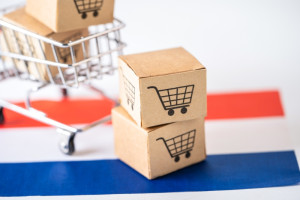Dutch online sales grew 2% in first half 2023

In the first half of this year, Dutch consumers spent 16.3 billion euros online. Compared to the same period in 2022, this is an increase of 2 percent. The online share of total spending was 31 percent, just like in 2022.
In the first six months of this year, 167.8 million purchases were completed online in the Netherlands. This is a share of 11 percent of all purchases within that period. These data come from the latest Thuiswinkel Market Monitor, conducted on behalf of Thuiswinkel.org and Retail Insiders.
3% less spent on products
The report also shows that consumers in the country spent 3 percent less on products in H1 of this year than in that period last year. The number of product purchases fell by 1 percent. Especially in Telecom and Home & Living less was spent (a decrease of 14 and 10 percent respectively). In contrast, spending in Sports & Recreation and DIY/Garden was higher than last year (up 9 and 6 percent, respectively).
The online share of total spending is still higher than in 2019.’
“During the corona period, consumers invested in their homes and home improvement, so those purchases were made then. Now consumers are more likely to choose events, outings or fixing things up themselves. Compared to 2019, the period before COVID-19, Dutch consumers are still spending more on online purchases. This may have to do with price increases, but we also see that the online share relative to total spending is still higher than back then”, said Marlene ten Ham, general director at Thuiswinkel.org.
Strong growth in services sector
The online services sector is actually showing growth after corona. Consumers spent 10 percent more on services in the first six months than in the same period last year. The number of purchases of services also increased by 5 percent. This growth comes mainly from package tours (19 percent more spending, 7 percent more purchases) and events (13 percent more spending, 10 percent more purchases).
‘Consumers do not save on experiences, but they do save on fixed expenses such as insurance.’
At the same time, however, there has been a decline in spending and purchases of insurance (down 11 and 20 percent, respectively). “Thus, consumers are not saving on experiences, but rather on fixed expenses such as insurance and telecom. Services are also increasingly bought online, from 83 percent of total purchases in 2019 to 87 percent in 2023. While shopping online, you can easily compare, on both supply and price.”
More cross-border purchases in Great Britain
The number of cross-border purchases rose 13 percent and spending abroad increased 8 percent. The Dutch consumer is buying more products abroad for less money. The share of foreign spending to Britain rose from 8 to 11 percent, to China from 5 to 6 percent.
Usage of smartphone and iDeal are growing
Purchases completed on smartphones increased from 33 percent to 35 percent between the first six months in 2022 and the first six months in 2023. In addition, consumers used iDeal more often (from 70 to 71 percent of all purchases). A larger share of spending was also made with this payment method (from 61 percent to 62 percent).
‘Credit card use increased thanks to the increase in cross-border purchases.’
In addition, credit card use increased in the share of spending (from 14 to 15 percent) and purchases (from 8 to 9 percent). This is mainly due to the increase in cross-border purchases. Also, Klarna’s share of online spending increased from 2 to 3 percent.

Comments